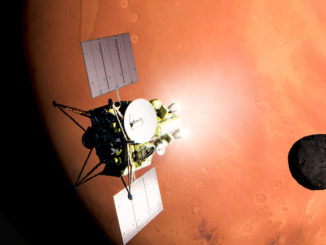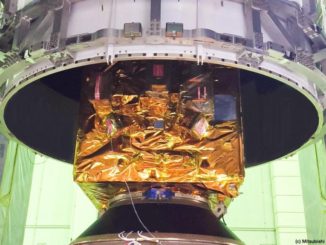
NASA’s Cassini orbiter sailed through the tenuous outermost reaches of Saturn’s atmosphere without trouble Monday, performing the first of five close swings nearer to the planet than any previous spacecraft before a final dive Sept. 15 to end the probe’s nearly 20-year mission.
The plutonium-powered spacecraft made its closest brush to Saturn yet, close enough to require the activation of its chemical rocket thrusters to keep it stable.
Cassini typically uses spinning gyro-like wheels buried inside the spacecraft to control its orientation with momentum shifts, but engineers were not sure the wheels were strong enough to counteract aerodynamic forces as the orbiter plowed through Saturn’s outer atmosphere.
The spacecraft came closest to Saturn at around 0422 GMT (12:22 a.m. EDT) Monday, and Cassini transmitted a radio signal nearly 24 hours later confirming it survived the flyby. NASA announced Tuesday that the first of five such dips into Saturn’s atmosphere was successful.
Cassini had used its rocket thrusters during many of the craft’s flybys of Saturn’s largest moon Titan, which has its own dense atmosphere.
“Cassini’s Titan flybys prepared us for these rapid passes through Saturn’s upper atmosphere,” said Earl Maize, Cassini project manager at NASA’s Jet Propulsion Laboratory in Pasadena, California, before Monday’s flyby. “Thanks to our past experience, the team is confident that we understand how the spacecraft will behave at the atmospheric densities our models predict.”
The spacecraft will soar less than 1,100 miles (1,770 kilometers) above Saturn’s cloud tops on each of its last five orbits, then spiral out beyond the rings to make successive egg-shaped loops around the planet.
Made mostly of hydrogen and helium, Saturn’s atmosphere of golden haze sits above dense inner core scientists believe is made of rock and ice. One of the prime goals of Cassini’s final months is to make measurements of Saturn’s gravity and magnetic fields, data that could render an estimate of the core’s size.

Depending on the density of Saturn’s atmosphere at Cassini’s flyby altitude, ground controllers could command the probe to conduct “pop-up” or “pop-down” maneuvers to fly farther or closer to the planet on the next four dives.
Cassini’s final close-up encounter with Titan on April 22 rerouted the spacecraft’s orbit to pass between Saturn and its innermost ring, kicking off the mission’s “grand finale” with 22 week-long circuits of the solar system’s second-biggest planet.
Cassini’s instruments were programmed to directly measure particles of Saturn’s atmosphere during Monday’s flyby.
“As it makes these five dips into Saturn, followed by its final plunge, Cassini will become the first Saturn atmospheric probe,” said Linda Spilker, Cassini project scientist at JPL. “It’s long been a goal in planetary exploration to send a dedicated probe into the atmosphere of Saturn, and we’re laying the groundwork for future exploration with this first foray.”
Scientists have concepts for a future dedicated probe to descend into Saturn’s atmosphere to measure winds, density, and composition deep below the planet’s cloud tops. Cassini will give researchers a taste.
Cassini’s radar was expected to conduct sounding measurements to reveal the large-scale structure of Saturn’s atmosphere in a region hidden from the view of conventional cameras.
“Its radar will peer deep into the atmosphere to reveal small-scale features as fine as 16 miles (25 kilometers) wide — nearly 100 times smaller than the spacecraft could observe prior to the grand finale,” NASA said in a press release.
The final phase of Cassini’s mission has already produced one surprising discovery. The space between Saturn and its rings is emptier than scientists expected, with Cassini detecting fewer impacts of tiny dust particles than predicted.
Cassini conducted its final orbit adjustment with its on-board thrusters July 15, and the spacecraft is now on a collision course with Saturn.

A long-distance flyby of Titan on Sept. 11 will naturally nudge Cassini on a trajectory to fall into Saturn. The spacecraft will be crushed by Saturn’s atmosphere and will burn up, with the final radio signal from Cassini expected to arrive on Earth around 8 a.m. EDT (1200 GMT; 5 a.m. PDT) on Sept. 15.
Running low on fuel, Cassini has explored Saturn and its moons for more than 13 years. The robotic explorer launched Oct. 15, 1997, from Cape Canaveral on top of a Titan 4 rocket, and entered orbit around Saturn on June 30, 2004, after a 2.2 billion-mile (3.5 billion-kilometer) interplanetary journey.
Cassini deployed the European Space Agency’s Huygens lander for a descent to the surface of Titan in 2005.
Since its arrival, Cassini has circled Saturn almost 300 times, collected detailed imagery of Saturn’s atmosphere and mysterious hexagonal polar vortex, explored its rings in minute detail, and observed 49 of Saturn’s 62 known moons with close and long-range flybys.
Originally designed for a four-year tour of Saturn, the nearly $3.3 billion mission has far outlived its original lifetime, producing stunning imagery of the planet and documenting seasonal changes as the gaseous world completed almost half of one 29-year orbit around the sun.
Email the author.
Follow Stephen Clark on Twitter: @StephenClark1.



